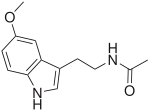Antioxidants are compounds that inhibit oxidation (usually occurring as autoxidation), a chemical reaction that can produce free radicals. Autoxidation...
94 KB (10,255 words) - 23:25, 13 November 2024
Antioxidants & Redox Signaling is a peer-reviewed scientific journal covering reduction–oxidation (redox) signaling and antioxidant research. It covers...
3 KB (122 words) - 04:54, 7 June 2022
Antioxidants is a peer-reviewed open-access scientific journal that covers various areas of antioxidants research, including biosynthesis, pharmacodynamics...
2 KB (139 words) - 22:38, 4 May 2023
mediated through the activation of melatonin receptors and its role as an antioxidant. In plants and bacteria, melatonin primarily serves as a defense mechanism...
68 KB (7,268 words) - 10:41, 5 November 2024
Iodide (redirect from Iodide as an antioxidant)
oxygen to give iodine. A reducing agent is a chemical term for an antioxidant. Its antioxidant properties can be expressed quantitatively as a redox potential :...
7 KB (583 words) - 04:40, 16 May 2024
Oxygen radical absorbance capacity (redirect from Antioxidant capacity)
Oxygen radical absorbance capacity (ORAC) was a method of measuring antioxidant capacities in biological samples in vitro. Because no physiological proof...
16 KB (1,815 words) - 04:41, 4 November 2024
The Trolox equivalent antioxidant capacity (TEAC) assay measures the antioxidant capacity of a given substance, as compared to the standard, Trolox. Most...
1 KB (107 words) - 09:19, 28 July 2022
voltammetry can be used to determine the antioxidant capacity in food and even skin. Low molecular weight antioxidants, molecules that prevent other molecules...
28 KB (3,490 words) - 08:03, 25 October 2024
A polyphenol antioxidant is a hypothesized type of antioxidant studied in vitro. Numbering over 4,000 distinct chemical structures mostly from plants...
12 KB (1,271 words) - 16:19, 29 September 2024
Folin–Ciocalteu reagent (redirect from Phenolic antioxidant)
used for the colorimetric in vitro assay of phenolic and polyphenolic antioxidants, also called the gallic acid equivalence method (GAE). It is named after...
7 KB (779 words) - 09:31, 20 April 2024




